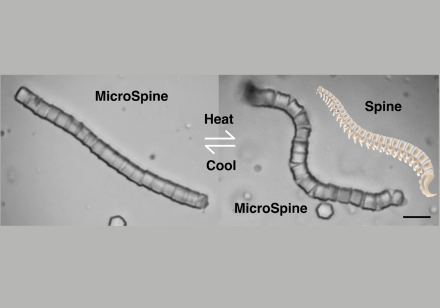06 Jul 2023
MicroSpine with Shape-Transforming Properties for Targeted Cargo Delivery at microscale

Microscale spine-mimicking structure, MicroSpine, has been created via colloidal assembly of soft and hard components, which can change shape by controlling temperature and can be utilised for cargo encapsulation and delivery. Image Credit: Dengping Lyu
In nature, it is common to find structures that combine both soft and hard material. These structures are responsible for diverse mechanical properties and functions of biological systems. As a typical example, the human spine possesses alternating stacks of hard bones and soft intervertebral discs, which is an essential architecture that supports the human body while maintaining body flexibility.Mimicking the soft-hard structure in nature can, in principle, inspire the design of artificial materials and devices, such as actuators and robots. However, the realisation has been extremely challenging, especially at the microscale, where material integration and manipulation become exceedingly less practical. With the goal of advancing biomimetic microscale materials, the research team led by Dr Yufeng WANG from the Department of Chemistry of The University of Hong Kong (HKU) has developed a new method to create microscale superstructures, called MicroSpine, that possess both soft and hard materials which mimic the spine structure and can act as microactuators with shape-transforming properties.This breakthrough, published in the top scientific journal Science Advances, was achieved through colloidal assembly, a simple process in which nano- and microparticles spontaneously organise into ordered spatial patterns.
Many biological organisms, ranging from mammals to arthropods and microorganisms, contain structures of synergistically integrated soft and hard components. These structures exist in different lengths, from micrometres to centimetres, and account for the characteristic mechanical functions of biological systems. They have also stimulated the creation of artificial materials and devices, such as actuators and robots, which change shape, move, or actuate according to external cues.

Microscale spine-mimicking structure, MicroSpine, has been created via colloidal assembly of soft and hard components, which can change shape by controlling temperature and can be utilised for cargo encapsulation and delivery. Image Credit: Dengping Lyu
Although soft-hard structures are easy to fabricate at the macroscale (millimetre and above), they are much harder to realise at the microscale (micrometre and below). This is because it becomes increasingly challenging to integrate and manipulate mechanically distinct components at smaller scale. Traditional manufacturing methods, such as lithography, face several limitations when attempting to create small-scale components using top-down strategies. For example, low yield can occur because small-scale manufacturing processes are more complex and require greater precision, which can increase the risk of defects and errors in the final product.
To tackle the challenge, Dr Wang and his team took a different approach, called colloidal assembly. Colloids are tiny particles 1/100 the size of human hair and can be made from various materials. When properly engineered, the particles can interact with one another, spontaneously assembling into ordered superstructures. As a bottom-up method, colloidal assembly is advantageous for making microscale structures because it allows for precise control over the creation of the desired structures from various building blocks, possessing a higher yield. Yet, the difficulty is how to guide the particles to assemble to the desired soft-hard structure.
By using the spine as a basis for design, the team has invented new particles derived from metal-organic frameworks(MOFs), an emerging material that can assemble with high directionality and specificity. Being also the hard component, these MOF particles can combine with soft liquid droplets to form linear chains. The hard and soft components take alternating positions in the chain, mimicking the spine structure, that is, the MicroSpine.
‘We also introduce a mechanism by which the soft component of the chain can expand and shrink when MicroSpine is heated or cooled, so it can change shape reversibly,’ explained Ms Dengping LYU, the first author of the paper, as well as the PhD Candidate in the Department of Chemistry at HKU.
Using the MicroSpine system, the team also demonstrated various precise actuation modes when the soft parts of the chain are selectively modified. In addition, the chains have been used for encapsulation and release of guest objects, solely controlled by temperature.
The realisation of these functions is significant for the future development of the system, as it could lead to the creation of intelligent microrobots capable of performing sophisticated microscale tasks, such as drug delivery, localised sensing and other applications.The highly uniform and precisely structured microscale components could be used to create more effective drug delivery systems or sensors that can detect specific molecules with high sensitivity and accuracy.
The research team believes this technology represents an important step towards creating complex microscale devices and machines. According to Dr Wang, ‘If you think about modern machinery such as cars, they are assembled by tens of thousands of different parts. We aim to achieve the same level of complexity using different colloidal parts.’ By taking inspiration from nature, the research team hopes to design more biomimetic systems that can perform complex tasks at the microscale and beyond.
Title of the Journal Paper: Biomimetic Thermoresponsive Superstructures by Colloidal Soft-and-Hard Co-Assembly, Science Advances, 9, eadh2250 (2023). DOI:10.1126/sciadv.adh2250
Click here to view the Journal Paper.
The research is funded by the Research Grants Council (RGC).
Learn more about Dr Yufeng Wang: Dr Yufeng Wang is an Associate Professor in the Department of Chemistry at HKU. As a material chemist, Dr Wang and his team specialise in designing anisotropic particles, which are the essential components for creating mesoscale materials with applications in photonics, sensing, micro robotics, cargo delivery, and active matter. Dr Wang’s research has been published in high-profile Journals including Nature, Nature Communications, Science Advances, JACS, Angewandte Chemie, etc. He has received the prestigious Croucher Innovation Award 2019, the NSFC Excellent Young Scientist Fund 2020, and the HKU Outstanding Young Research Award 2022. Dr Wang obtained his BSc degree from Peking University in 2008 and his PhD degree from New York University in 2013. Before joining HKU in 2016, he completed his postdoctoral training at MIT.
More information about Dr Yufeng Wang’s research group: https://wanglab.hku.hk







